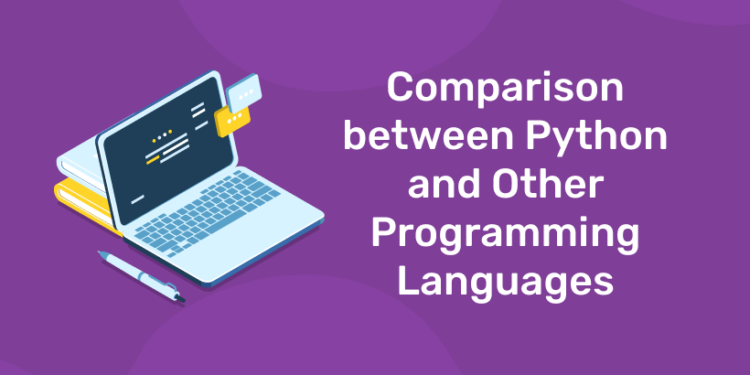Table of Contents
An easily adaptable programming language that offers a lot of features. Its concise syntax and open-source nature promote readability and implementation of programs which makes it the fastest-growing programming language in current times. Python has various other advantages which give it an edge over other popular programming languages such as Java and C++.
Python vs Java
- In Python there is no need for semicolon and curly braces in the program as compared to Java which will show syntax error if one forgot to add curly braces or semicolon in the program.
- Python code requires fewer lines of code as compare to Java to write the same program. For Example, Here is a code in Java
publicclassPythonandJava {publicstaticvoidmain(String[] args){System.out.println("Python and Java!");}}Output:
Python and Java!
Same code written in Python
print("Python and Java !")Output:
Python and Java!
- Python is dynamically typed which means one has to only assign a value to a variable at runtime, Python interpreter will detect the data type on itself as compared to Java where one has to explicitly mention the data type.
- Python supports various type of programming models such as imperative, object-oriented and procedural programming as compared to Java which is completely based on the object and class-based programming models.
- Python is easy to read and learn which is beneficial for beginners who are looking forward to understanding the fundamentals of programming quickly as compared to Java which has a steep learning curve due to its predefined complex syntaxes.
- Python concise syntax makes it a much better option for people of other disciplines who want to use programming language for data mining, neural processing, Machine Learning or statistical analysis as compared to Java syntax which is long and hard to read.
- Python is free and open-source means its code is available to the public on repositories and it is free for commercial purposes as compared to Java which may require a paid license to be used for large scale application development.
- Python code requires fewer resources to run since it directly gets compiled into machine code as compare to Java which first compiles to byte code, then needs to be compiled to machine code by the Java Virtual Machine(JVM).
“Ready to take your python skills to the next level? Sign up for a free demo today!”
Python vs C++
1: Which of the following data types is immutable in Python?
- Python is more memory efficient because of its automatic garbage collection as compared to C++ which does not support garbage collection.
- Python code is easy to learn, use and write as compared to C++ which is hard to understand and use because of its complex syntax.
- Python uses an interpreter to execute the code which makes it easy to run on almost every computer or operating system. as compared to C++ code which does not run on other computers until it is compiled on that computer.
- Python can be easily used for rapid application development because of its smaller code size as compared to C++ which is impossible to use for rapid application development because of it large code fragments.
- Readability of Python code is more since it resembles actual English as compared to C++ code which contains hard to read structures and syntaxes.
- Variables defined in Python are easily accessible outside the loop as compared to C++ in which scope of variables is limited within the loop.
🚀 Start Coding Today! Enroll Now with Easy EMI Options. 💳✨
Gain expertise in Django and open doors to lucrative opportunities in web development.
Start Learning With EMI Payment OptionsComparing Python to Other Languages
Python is often compared to other interpreted languages such as Java, JavaScript, Perl, Tcl, or Smalltalk. Comparisons to C++, Common Lisp and Scheme can also be enlightening. In this section, we will briefly compare Python to each of these languages. These comparisons concentrate on language issues only. In practice, the choice of a programming language is often dictated by other real-world constraints such as cost, availability, training, and prior investment, or even emotional attachment. Since these aspects are highly variable, it seems a waste of time to consider them much for this comparison.
“Experience the power of our web development course with a free demo – enroll now!”
Java
Python programs are generally expected to run slower than Java programs, but they also take much less time to develop. Python programs are typically 3-5 times shorter than equivalent Java programs. This difference can be attributed to Python’s built-in high-level data types and its dynamic typing. For example, a Python programmer wastes no time declaring the types of arguments or variables, and Python’s powerful polymorphic list and dictionary types, for which rich syntactic support is built straight into the language, find a use in almost every Python program. Because of the run-time typing, Python’s run time must work harder than Java’s. For example, when evaluating the expression a+b, it must first inspect the objects a and b to find out their type, which is not known at compile time. It then invokes the appropriate addition operation, which may be an overloaded user-defined method. Java, on the other hand, can perform an efficient integer or floating point addition, but requires variable declarations for a and b, and does not allow overloading of the + operator for instances of user-defined classes.
For these reasons, Python is much better suited as a “glue” language, while Java is better characterized as a low-level implementation language. In fact, the two together make an excellent combination. Components can be developed in Java and combined to form applications in Python; Python can also be used to prototype components until their design can be “hardened” in a Java implementation. To support this type of development, a Python implementation written in Java is under development, which allows calling Python code from Java and vice versa.
Javascript
Python’s “object-based” subset is roughly equivalent to JavaScript. Like JavaScript (and unlike Java), Python supports a programming style that uses simple functions and variables without engaging in class definitions. However, for JavaScript, that’s all there is. Python, on the other hand, supports writing much larger programs and better code reuse through a true object-oriented programming style, where classes and inheritance play an important role.
🚀 Start Coding Today! Enroll Now with Easy EMI Options. 💳✨
Gain expertise in Django and open doors to lucrative opportunities in web development.
Start Learning With EMI Payment OptionsPerl
Python and Perl come from a similar background (Unix scripting, which both have long outgrown), and sport many similar features, but have a different philosophy. Perl emphasizes support for common application-oriented tasks, e.g. by having built-in regular expressions, file scanning and report generating features. Python emphasizes support for common programming methodologies such as data structure design and object-oriented programming, and encourages programmers to write readable (and thus maintainable) code by providing an elegant but not overly cryptic notation. As a consequence, Python comes close to Perl but rarely beats it in its original application domain; however Python has an applicability well beyond Perl’s niche.
Tcl
Like Python, Tcl is usable as an application extension language, as well as a stand-alone programming language. However, Tcl, which traditionally stores all data as strings, is weak on data structures, and executes typical code much slower than Python. Tcl also lacks features needed for writing large programs, such as modular namespaces. Thus, while a “typical” large application using Tcl usually contains Tcl extensions written in C or C++ that are specific to that application, an equivalent Python application can often be written in “pure Python”. Of course, pure Python development is much quicker than having to write and debug a C or C++ component. It has been said that Tcl’s one redeeming quality is the Tk toolkit. Python has adopted an interface to Tk as its standard GUI component library.
Tcl 8.0 addresses the speed issuse by providing a bytecode compiler with limited data type support, and adds namespaces. However, it is still a much more cumbersome programming language.
Smalltalk
Perhaps the biggest difference between Python and Smalltalk is Python’s more “mainstream” syntax, which gives it a leg up on programmer training. Like Smalltalk, Python has dynamic typing and binding, and everything in Python is an object. However, Python distinguishes built-in object types from user-defined classes, and currently doesn’t allow inheritance from built-in types. Smalltalk’s standard library of collection data types is more refined, while Python’s library has more facilities for dealing with Internet and WWW realities such as email, HTML and FTP.
Python has a different philosophy regarding the development environment and distribution of code. Where Smalltalk traditionally has a monolithic “system image” which comprises both the environment and the user’s program, Python stores both standard modules and user modules in individual files which can easily be rearranged or distributed outside the system. One consequence is that there is more than one option for attaching a Graphical User Interface (GUI) to a Python program, since the GUI is not built into the system.
C++
Almost everything said for Java also applies for C++, just more so: where Python code is typically 3-5 times shorter than equivalent Java code, it is often 5-10 times shorter than equivalent C++ code! Anecdotal evidence suggests that one Python programmer can finish in two months what two C++ programmers can’t complete in a year. Python shines as a glue language, used to combine components written in C++.
Common Lisp and Scheme
These languages are close to Python in their dynamic semantics, but so different in their approach to syntax that a comparison becomes almost a religious argument: is Lisp’s lack of syntax an advantage or a disadvantage? It should be noted that Python has introspective capabilities similar to those of Lisp, and Python programs can construct and execute program fragments on the fly. Usually, real-world properties are decisive: Common Lisp is big (in every sense), and the Scheme world is fragmented between many incompatible versions, where Python has a single, free, compact implementation.
“Get hands-on with our python course – sign up for a free demo!”












